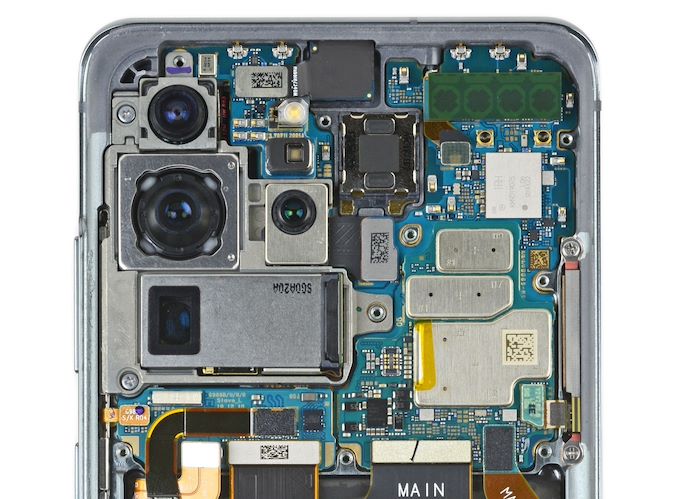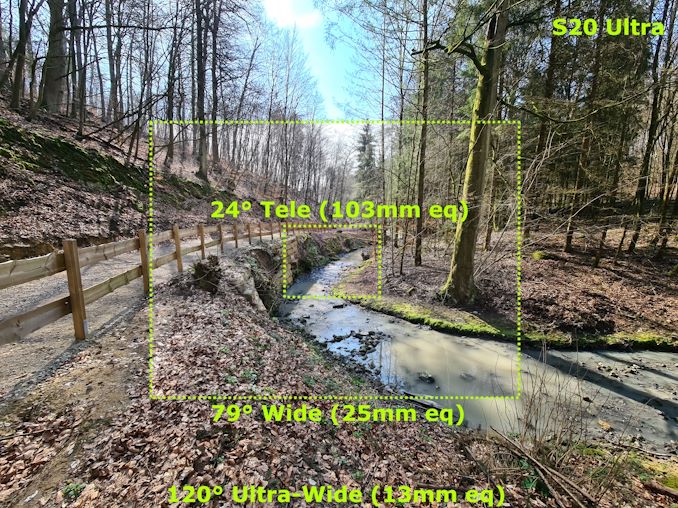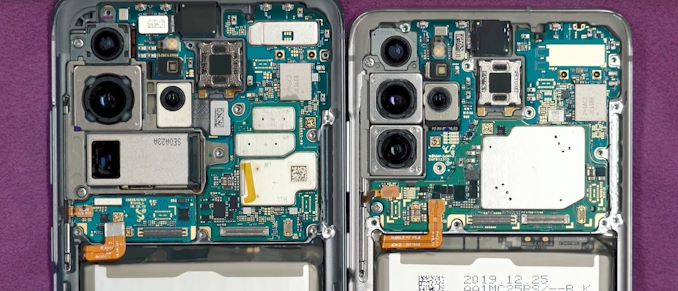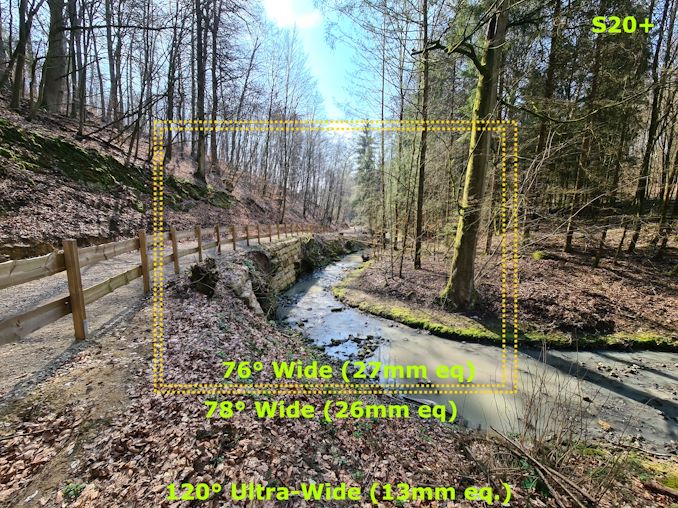The Samsung Galaxy S20+, S20 Ultra Exynos & Snapdragon Review: Megalomania Devices
by Andrei Frumusanu on April 3, 2020 9:30 AM ESTCamera Architecture: Huge New Sensors
As we move on to the camera evaluation of the S20 series, I think it would be good to recap the new sensor architectures that Samsung is deploying in its new flagships. To say that this is the biggest camera hardware upgrade that Samsung has ever embarked on is a bit of an understatement, as the new modules on the S20 series, and in particular the S20 Ultra, have seen some fundamental shifts in terms of their designs and specifications.
| Samsung Galaxy S20 Series Cameras | ||||
| Galaxy S20 | Galaxy S20+ | Galaxy S20 Ultra | ||
| Primary Rear Camera | 79° Wide Angle 12MP 1.8µm Dual Pixel PDAF |
79° Wide Angle 108MP 0.8µm DP-PDAF 3x3 Pixel Binning to 12MP 8K24 Video Recording |
||
| fixed f/1.8 optics OIS, auto HDR, LED flash 4K60, 1080p240, 720p960 high-speed recording |
||||
| Secondary Rear Camera |
76° Wide Angle (Cropping / digital zooming telephoto) 64MP 0.8µm F/2.0 optics, OIS 8K24 Video Recording |
24° Telephoto (5x optical magnification) 48MP 0.8µm 2x2 Pixel Binning to 12MP F/3.5 prism optics, OIS |
||
| Tertiary Rear Camera |
120° Ultra-Wide Angle 12MP 1.4µm f/2.2 |
|||
| Extra Camera |
- | Time of Flight (ToF) 3D Sensor | ||
Starting off with the elephant in the room, that’s the new S20 Ultra. Last year we first saw talk of Samsung LSI introducing a new 108MP camera sensor that had been developed in collaboration with Xiaomi. Although closely related to that design, the HM1 sensor is a bit different to the HMX sensor that’s employed in the Xiaomi phones. What’s special about these new sensors is their sheer size: at 1/1.33”, it’s over double the sensor area of previous generation units found in past Galaxy phones. A lot of people will criticize the 108MP count as being a gimmick, but in light of the huge new sensor the actual pixel pitches aren’t exactly all that smaller than what we’ve seen from previous generation high-megapixel sensors from the last year or two, still falling in at 0.8µm.
![]() Source: TechInsights
Source: TechInsights
What’s rather peculiar about the HM1 sensor in the S20 Ultra though is that this isn’t just another quad-Bayer sensor like those seen in other designs over the year, but rather a “Nonacell” design, with the color filter array covering up 9 subpixels. Just like quad-Bayer designs, the new nona-Bayer sensor is able to demosaic chroma information to be able to actually achieve the advertised 108MP resolutions. Physically, chroma resolution still is only 12MP on the sensor, and that’s something that you’ll want to keep in mind when we’ll later on investigate the 108MP samples of the phone.

Source: iFixit
As seen in the above teardown shot, the 108MP unit dwarfs the other sensors in the phone, but this does come with some complications. On the optics side, Samsung has now opted for a fixed f/1.8 aperture and has dropped the dual-aperture f/1.5-2.4 system we’ve seen on the S9 and S10 series. Because the new sensor is so huge, it actually becomes an issue to design proper optics that actually fit into the z-height of the phone. Even though the S20 Ultra has a thick camera bump now, it still has to make do with a smaller aperture optical lens than previous generations. The new bigger sensor also has another side-effect, that being a shallower depth of field when focusing on objects. I do find it a very big pity that Samsung opted to drop the dual-aperture system as that would have been the perfect fit for such a big sensor design and essentially eliminate any potential drawbacks on the optics side. Unfortunately, as it’s gone, I do expect the optics to not perform quite as optimally as we’ve seen on the S10 series.
Below the 108MP sensor, we find another unique design that’s exclusive to Samsung at this moment, and that’s the new periscope design telephoto module. Such modules were pioneered by Huawei as we first saw the P30 Pro last year bring it to the mass market, however Samsung goes way beyond what any other vendors is currently brining to the market. The optical magnification of Samsung’s design isn’t too special, only reaching a factor of 4x and a resulting 24° field of view or 103mm equivalent focal length. What is special though is that Samsung has crammed in a full 48MP IMX586 into the module, going far beyond the smaller 12 or 8MP sensors that are being deployed by other vendors such as Huawei. It’s the usage of such a big sensor that lies perpendicular to the body of the phone that actually forces the S20 Ultra to have such a huge camera bump on the back – as it’s being limited by the thickness and the footprint of the telephoto camera module.

To square off the trio of cameras on the S20 Ultra, we see a new ultra-wide-angle module. Samsung here opted to go for a lower megapixel count sensor at 12MP compared to 16MP on the S10 series, but the pixel pitch increases from 1.0µm to 1.4µm, which should allow it go achieve better per-pixel sharpness and low-light capturing abilities. It remains quite wide at a 120° viewing angle, just a tad tighter than 123° unit on the S10 series.
When looking at the different viewing angles of the S20 Ultra, we see some big discrete steps between what the different sensors are able to natively capture at their fullest. The main sensor on the S20 Ultra is actually a tad wider than what Samsung is marketing, and it produces 25mm equivalent focal length images, a little wider than the 26mm of the S10 series and the other S20 phones. Of course, the telephoto lens will have a small field of view of only 24°, but that’s precisely what allows it to achieve such high magnification levels, also thanks to the high resolution captured within this frame.

Source: ITSub
While the S20 Ultra’s camera design is fascinating, the design that actually excited me a lot more when the phones were first introduced is the camera trio that’s found on the regular S20 and S20+. Here Samsung is using a completely different approach that’s pretty much unique in the industry.
Starting off with the main sensor, this is seemingly a pretty straightforward design that really only differentiates itself through the fact that’s it’s now a bigger sensor falling in at 1/1.76”. The resolution still is 12MP and it’s a regular Bayer sensor, so pixel pitches now grow to 1.8µm. The optics remain similar to the S20 Ultra’s, coming with a fixed f/1.8 aperture lacking the dual-aperture system and of course also includes OIS. The Ultra-Wide-Angle is also the same as on the S20 Ultra.
What’s really exciting about the S20 and S20+ is the “telephoto” module. The weird part is that this isn’t a telephoto module at all, but it’s an actual secondary wide-angle lens that’s only slightly tighter than the main camera. The sensor here is also large at 1/1.76”, but it comes a 64MP resolution with 0.8µm pixels. I actually haven’t heard confirmation of the color filter array of the unit, whether it’s quad-Bayer with remosaic or whether it’s a true 64MP Bayer sensor.
Why Samsung is able to call this a 3x telephoto module is that when cropping a 1:1 12MP picture out of it, it does end up at a 3x magnification in relation to the main camera sensor. The question you’re of course posing, is why would Samsung go for such a camera configuration? The first answer, possibly the most obvious one, is 8K video recording. As the main camera unit’s 12MP native resolution isn’t sufficient for 8K video recording, Samsung needed to find a way to include this into the regular S20 series as well – and obviously if you had an actual telephoto module for this then you’d end up with a pretty useless setup. Going for a secondary wide-angle module kills two birds with one stone, as you have one module being able to serve as the 8K video recording unit as well as taking advantage of the high-megapixel count of the unit to be able to achieve respectable crop-zooming.
I was most excited about this setup, more-so than that of the S20 Ultra, because it opens up a lot of possibilities in terms of sensor fusion and computational photography that’s physically just not possible on the S20U. Without spoiling the camera evaluations too much, this also means that the S20 and S20+ have quite high quality zoom capabilities in the 1-3x range as well, and it doesn’t behave as a “normal“ telephoto module at these intermediate levels.











137 Comments
View All Comments
crimson117 - Friday, April 3, 2020 - link
$1400 is absurd. There's no way they're worth more than twice as much as a brand new S10.Andrei Frumusanu - Friday, April 3, 2020 - link
Probably one of the reasons Samsung still continues to sell the S10 series. They're really excellent value right now, and you're not missing out on too much.cha0z_ - Monday, April 6, 2020 - link
You are literally getting just one more year of software support going for s10 series... samsung software support policy is abysmal with less than two years of real support and from there just security. I got both iphone 11 pro max and exynos note 9, if I put aside the cr*ppy 9810 - it will not receive even the oneUI 2.1 as an update, while samsung will soon release it for s10 line. Enough said, note 9 is year and a half old.How can you recommend someone 1000 euro or 1400 euro phone if it will be supported for 1.5 years and from there 1.5 more security updates next to apple with 5 years FULL support with major, minor, day one, betas + security update for old iphones like 4s and 5 (2011 and 2012 respectably)?
goatfajitas - Monday, April 6, 2020 - link
You do realize the phone doesn't stop working when it doesn't get an OS update right? TBH, neither Android or IOS has added a whole lot in the past few years, its just a yearly cadence of very minor updates and not getting them means almost zero in actual use.Featherinmycap - Monday, April 6, 2020 - link
I think there have been a lot of added features to IOS in the last 3 years that I use a great deal. Not saying that Android didnt already have some of these features, but for IOS users we got with IOS 11; a file manager (finally), Messages sync with iCloud, screen recording, useful improvements to Siri and ApplePay. IOS12; lots of performance improvements (lots), Screentime, Shortcuts (scripting), CarPlay, Animoji Memoji, Tracking prevention, IOS13; Single Sign on, external storage, Dark Mode, better support for keyboards, trackpads/mice, etc.Famorcan007 - Tuesday, April 7, 2020 - link
I think it's because Android mostly has offered those features(file manager,screen recording, external storage,support for mice etc.) since way back compared to iOS' slow but steady trickle of features that's why iOS users feel every OS update is huge and significant. I'm using a Note 4(my backup device) right now to comment which doesn't feel too crippled compared to my Android 9 P20 pro.cha0z_ - Tuesday, April 7, 2020 - link
Let's not find an excuse - software support is software support. Security is security - some of us keep all their personal info on their device (most of us) + bank accounts and whatnot, risking compromise on your phone is not that innocent compared to what was like back in the days. IOS adds rapidly more features for sure compared to android that recently starts to look more and more like IOS (and I personally totally don't like that), but still added some good stuff under the hood and some new features.It's not serious to sell 1400 euro phone that is supported for one year and a half. I own exynos note 9 - it's 1.5 years old and already samsung dropped the support, s10 line received oneUI 2.1, note 9 will not. How is that for my 1000 euro phone + double served with that cr*ppy exynos 9810 in it. Now it's in my GF and I am rolling iphone 11 pro max. I prefer android and love oneUI, but I am tired to be a second hand customer.
s.yu - Tuesday, April 7, 2020 - link
Don't know what you're talking about. My Note8 just got another update days ago, one that I preferred not to have because each update comes with a risk of bricking the device while potential changes to the UI are not always welcome either. I also got it ~30% off retail a few months after release, such has always been the state of Samsung, at least for S and Note.I'm no longer buying Samsung but the main reason is lack of the 3.5mm port, if I have to name another then it's between the questionable choice of telephoto in the smaller variants or the oversized device with a mediocre battery(I regard 5000mah to be mediocre for the size). I still do like the UI but I'm willing to look around.
Psyside - Tuesday, April 7, 2020 - link
"It's not serious to sell 1400 euro phone that is supported for one year and a half. I own exynos note 9 - it's 1.5 years old and already samsung dropped the support, s10 line received oneUI 2.1, note 9 will not. How is that for my 1000 euro phone"Very easy, with those "very old software features" Samsung can do what MAC can't, and don't get me start it on the utter crap IOS.
Also don't spin it, Samsung offer 4 (four) years of security updates, so do your research before you type something.
cha0z_ - Wednesday, April 8, 2020 - link
fanboy. Security update hahahahah iphone 4s and 5 still receives security updates - 9 years old phone for 4s. What you will say now?iphone receive FULL support with MAJOR ios versions, updates, minor updates, BETA versions, DAY ONE as their newest and most expensive phone - for 5-6 years and you are talking about 4 years of security updates roflmao. Samsung released note 9 with android 8 when android 9 was already released from more than a months. Oooo, it's enough time, because you can dev your skin and features on top of the dev previews, especially the later ones that are closer to final (for the more tricky/deeply integrated code) - so no excuse for what they did. Basically they gave me one major update - android 10 as android 9 should had been on the note 9 from the start. Even if we count 2, how is that next to 5-6 versions of ios?
And before you talk some more fanboy bs that never used recent years iphones - ios brings a lot more in every new versions (adding features that was missing for no reason, like external USB flash support, file browser for the files on the phone, etc) while android 10 brings you what? More lockdown ios style, iphones gestures and pixel device that is a cheap iphone wannabe.
Because of people like you samsung don't want to change their software support policy. Why should they? It costs money or now you will start with the argument how the phone hardware is not supporting oneUI 2.1 (for the note 9 that is 1.5 years old, but will not receive it most likely ;) ). Or maybe android 11 will be too much for the phone, right? :D
Also I agree - my note 9 can do more than my iphone 11 pro max, but everything that the phones do both (and that's 99.9% of what you will end up using constantly) - the iphone 11 pro max makes the exynos note 9 look like a total utter joke - faster, smoother with NOT A SINGLE frame drop no matter what you do, gaming is insanely good with surprise - NOT A SINGLE frame drop, battery life is x3 times better, apps have MORE features and runs super smooth and great, speakers destroys the note 9 one, camera too is times better, materials are a lot better too, faceid is super good and fast - feels like I don't have any security on - never failed or gave me any issue. Fun fact, note 9 came with fortnite and recommended as gaming phone for that game. My exynos variant can't run smoothly the game even with 30fps cap medium settings and !1080p! while iphone XS max runs it 60fps high 2688x1242 without a single frame drop. Same goes for the 11 pro max, obviously.
As for ios - it improves massively and adds more and more missing features/drops restrictions with every version. ios 14 is already known to drop more. I prefer android, because I can do more + I love oneUI, but that doesn't change the fact that in my country I will receive exynos and 1.5 years of decent support. And in the end of the day - I spend my time in apps, not in the settings menu and apps on ios are better, with more features, smoother, a lot of them exclusive to the platform. Can you play dead cells on your android device? No? Yeah, the port is expected around the end of the year, I have it from June 2019. Full blown civilization 6 on your android device? Yeah, will never come, I have it and it's 1:1 port that runs great. Can go on and on and on. If you spend your time tweaking settings, options, UI - good for you, I spend my time in games and apps.